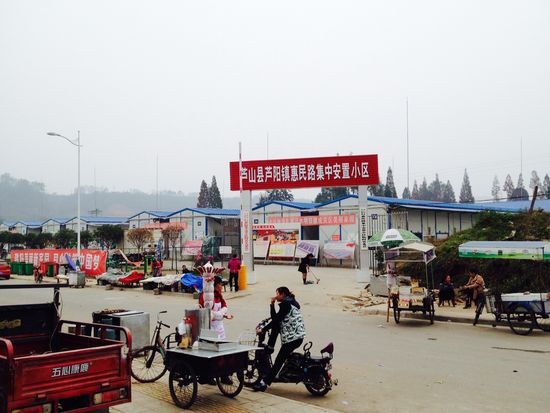


Dr. Chern Jenn-Chuan Invited on Post-Disaster Reconstruction Field Visit and Experience Exchange after Sichuan Province’s Lushan Earthquake

CEO of the Morakot Post-Disaster Reconstruction Council, Executive Yuan, Dr. Chern Jenn-chuan, was invited to share his experience in reconstruction during visits throughout Mainland China. On November 20th, 2013, with the accompaniment of deputy chief Hsieh Ling-zhi of the Western China Earthquake and Hazards Mitigation Research Centre, Dr. Chern went deep into major disaster zones such as Qionglai City of Sichuan Province, and Ya’an City of Lushan County to better understand the scope of the disasters, the post-disaster reconstruction situation, and share his experiences involved in Taiwan’s Morakot post-disaster reconstruction.
Since the Wenchuan Earthquake took place 5 years ago in Sichuan Province of Mainland China, another major earthquake known as the “420 Lushan Earthquake” took place on April 20th, 2013 at a depth of 13 km, had a magnitude measuring 7.0 and an epicenter located in Lushan County, Ya’an City, Sichuan Province. According to public information on structural damage after the Lushan Earthquake, statistics showed that more than 24,000 houses had collapsed, 72,400 rooms had collapsed, 85,300 houses and 295,600 rooms had been severely damaged, while 264,000 houses and 1,173,300 rooms had been moderately damaged by 19:00, April 22nd. According to data published by the China Earthquake Administration, there were 196 deaths, 21 people missing, and 11,470 people injured as the result of this earthquake as of April 24th. Compared to Wenchuan Earthquake, the extensive mobilization by the central government and full support of all provinces, there was drastically less outside support after this earthquake, due to its smaller scale of damage. It was a challenge for the provincial and local governments in terms of reconstruction capabilities.
CEO Chern stated that the school buildings and main residential structures constructed through aid from various organizations after the Wenchuan Earthquake, in accordance with new seismic regulations, mostly survived the challenge of this major earthquake. However, much damage was incurred to subsidiary facilities on some newly constructed buildings, such as the ceilings and decor, so fortifications and repairs require temporary arrangements. Each city should fortify structures on site, tear down and rebuild on side, or resettle communities on different sites after conducting safety examinations on these buildings, respecting public opinion, and taking their own ability and local opinion into account. The mainland Chinese government is providing partial funding and low-interest loans when necessary for the first two options.
The groundbreaking ceremony took place on October 23rd for a large community constructed on public land, where construction costs were subsidized for about half of this thousand household structure. In the inner city of Lushan County, disaster victims moved into assembled housing in July 1st. The design and construction of this housing was fairly standardized and it can serve as a reference point. It features complete functionality including fire safety facilities, rec room, psychological guidance room, supermarket, police office, kitchen, and bathroom facilities. The disaster victims were still waiting on a decision for newly construction housing projects. In the countryside, residents mostly chose to fortify existing buildings or tear them down and rebuild for work convenience and better adaptation to their living environment. On the other hand, in more urbanized locations, most chose to tear their houses down and live in assembled housing as they await new community housing projects. In these reconstruction zones, residents who decided to rebuild on the original site can be seen busily constructing structures on either side of these rural roads. Though the homeland reconstruction route taken respects residents’ opinions, the extent of actual reconstruction still depends upon each household’s financial situation. Those in better financial shape tore down houses and reconstructed, while those who were less capable could only preserve the damaged structures or remove construction material and store them throughout the community, creating a chaotic scene. Thus, it may take some time to restore the community environment to its former order. This also means that they missed an opportunity to comprehensively plan and rebuild disaster-proof homes and a new community in these scenic rural environments. In addition, the localities still lacked a system for managing housing construction in rural areas. There is an absence of technicians, architects or other professionals to supervise designs. Thus, there is a large gray area in terms of which houses should be condemned, which houses are safe after fortification, etc. Balancing respect for residents with safety is a major challenge for the government. As a whole, with the post-disaster reconstruction experience after the Wenchuan Earthquake, reconstruction efforts are now well underway. Though there is a lack of strong support from the central government and non-governmental organizations, it is up to the local government to take on the burden of effective reconstruction.
Compared to Taiwan’s Morakot post-disaster reconstruction experience, CEO Chern pointed out that Taiwan utilized a one-step policy of permanent housing, utilized the Special Act to simplify administrative procedures, implemented comfortable short term placement in army barracks, and assertively accelerated policies to construct permanent housing. Merely half a year after the disaster, 610 households moved into the Shanlin Tzuchi Daai Permanent Housing Community constructed jointly by the Tzuchi Foundation and the government. This was an exceptional reconstruction experience, as quality and speed of reconstruction were both excellent.
CEO Chern stated that Taiwan’s 921 Earthquake, Typhoon Morakot, China’s Wenchuan Earthquake and heavy rains the following day, Lushan Earthquake, and the Philippines’ Typhoon Haiyan each had its own unique characteristics and experience. The disaster relief and reconstruction methods required for floods, mudslides, collapses, and high waters resulting from major earthquakes and typhoons might differ. More attention should be paid to the long-term impact of interactions between torrential rain and earthquakes or typhoons. The global community as a whole should learn from one another and seek constant progress regarding short and long-term impacts of disaster victim settlement on their life, industry, and psychology.

Lushan 420 Earthquake Relocation Place

Lushan 420 Eathquake Reconstruction Area

Lushan 420 Eathquake Reconstruction Area

Assembled housing for Relocation





